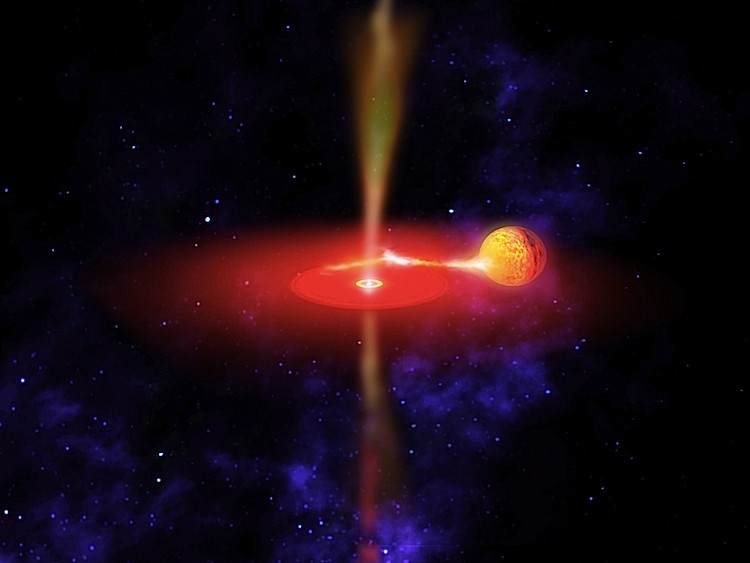NASA’s Wide-field Infrared Survey Explorer (WISE) has imaged a jet flaring from a black hole named GX 339-4, more than 20,000 light-years away, near the heart of the Milky Way.
For the first time ever, WISE’s infrared vision allowed a team of astronomers to zoom in on the inner regions of the jet’s base, its brightest point.
“Imagine what it would be like if our sun were to undergo sudden, random bursts, becoming three times brighter in a matter of hours and then fading back again,” said study lead author Poshak Gandhi at the Japan Aerospace Exploration Agency (JAXA) in a press release. “That’s the kind of fury we observed in this jet.”
GX 339-4 is ultra-dense, with a mass at least six times that of our sun. It is fed by matter from a companion star, some of which shoots out as the jet at almost the speed of light.
“To see bright flaring activity from a black hole, you need to be looking at the right place at the right time,” said Peter Eisenhardt at NASA’s Jet Propulsion Laboratory in California, in the release.
“WISE snapped sensitive infrared pictures every 11 seconds for a year, covering the whole sky, allowing it to catch this rare event.”
The surprising results revealed dramatic irregular changes in jet activity across variable periods from 11 seconds to a few hours. They showed that the radius of the jet’s base varies from around 15,000 miles (24,140 kilometers) to tenfold or more.
“If you think of the black hole’s jet as a firehose, then it’s as if we’ve discovered the flow is intermittent and the hose itself is varying wildly in size,” Gandhi said.
The observations also allowed the most accurate measurements to date of the black hole’s magnetic field, which is 30,000 times stronger than that of Earth’s surface, and which channels and accelerates matter into the thin jet.
The findings will be published in The Astrophysical Journal Letters on Oct. 10.
For the first time ever, WISE’s infrared vision allowed a team of astronomers to zoom in on the inner regions of the jet’s base, its brightest point.
“Imagine what it would be like if our sun were to undergo sudden, random bursts, becoming three times brighter in a matter of hours and then fading back again,” said study lead author Poshak Gandhi at the Japan Aerospace Exploration Agency (JAXA) in a press release. “That’s the kind of fury we observed in this jet.”
GX 339-4 is ultra-dense, with a mass at least six times that of our sun. It is fed by matter from a companion star, some of which shoots out as the jet at almost the speed of light.
“To see bright flaring activity from a black hole, you need to be looking at the right place at the right time,” said Peter Eisenhardt at NASA’s Jet Propulsion Laboratory in California, in the release.
“WISE snapped sensitive infrared pictures every 11 seconds for a year, covering the whole sky, allowing it to catch this rare event.”
The surprising results revealed dramatic irregular changes in jet activity across variable periods from 11 seconds to a few hours. They showed that the radius of the jet’s base varies from around 15,000 miles (24,140 kilometers) to tenfold or more.
“If you think of the black hole’s jet as a firehose, then it’s as if we’ve discovered the flow is intermittent and the hose itself is varying wildly in size,” Gandhi said.
The observations also allowed the most accurate measurements to date of the black hole’s magnetic field, which is 30,000 times stronger than that of Earth’s surface, and which channels and accelerates matter into the thin jet.
The findings will be published in The Astrophysical Journal Letters on Oct. 10.



